Ephemera: An Autograph Book Belonging to an Unknown Arthur, and Postcard Propaganda
I mentioned in the last entry in this series that I had been experimenting with a photography set-up. I chose this book from my collection next, which is considerably larger than a typical autograph book, to see if the set-up would still work. The result was so-so, with a bit of rejigging needed.
I have been unable to identify the book's origin, the owner, or any of the other individuals who have signed the book. All I can say is, the book was most likely an engagement present from a Francis Emily Cooke to an Arthur, circa 1910. From a census search, a possible suspect would be Arthur Puddefoot, born 1881, who, according to the 1911 census, lived in Middlesex and was married to a Francis Emily Cooke — but that is purely circumstantial.
The book, however, is of minor note: a green marbled cover, embossed with the gold text 'Writing Album', a velvet spine, and page edges finished with gold leaf. It was made by Valentine & Sons Limited, a Dundee company formed in 1825, which was once Scotland's leading manufacturers of picture postcards.1 The pages are of a high quality and holding them up to the light reveals a large watermark which reads 'Genuine Tor-Size Air Dried Vellum'. From a cursory search of autograph album prices for the year 1910, the cheapest I could find was 11 ½ d and the most expensive 4s 5d. I would hazard a guess and put this in the upper third of that price range.2
The book contains just 24 entries that were made, where identifiable, between 17 August 1910 and 15 April 1916 — there is also a later entry made by a graffiti artist dated 1939.
The Entries
Though only a small number of entries, I would count this as a fairly ordinary example, and there are three entries in particular I would like to highlight. The first is this one made by an Elsie Maude in 1914.
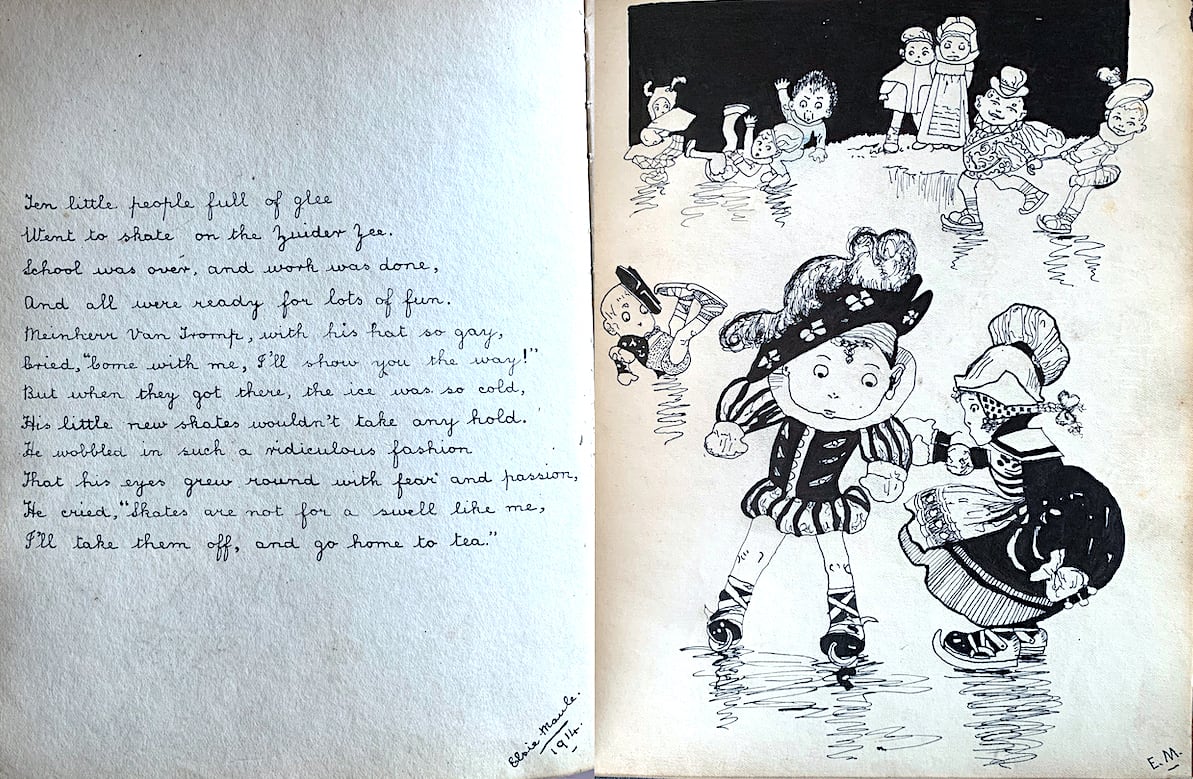
Transcript: (any errors are mine)
Ten little people full of glee
Went to skate on the guilder gee
School was over, and work was done,
And all were ready for lots of fun.
Meinherr van Tromp, with his hat so gay,
cried, "Home with me, I'll show you the way!"
But when they got there, the ice was so cold,
His little new skates wouldn't take any hold.
He wobbled in such a ridiculous fashion
That his eyes grew round with fear and passion
He cried, "Skates are not for a well like me, I'll them off and go
home to tea"Elsie Maude
1914
I am posting this in the hope that someone recognises it. Not only is it quite stylised, but I have also come cross numerous postcards and pictures of a similar ilk for the period. I am wondering if there was a popular children's book which would explain the frequency and theme of such illustrations?
The second entry is the following from 1916:
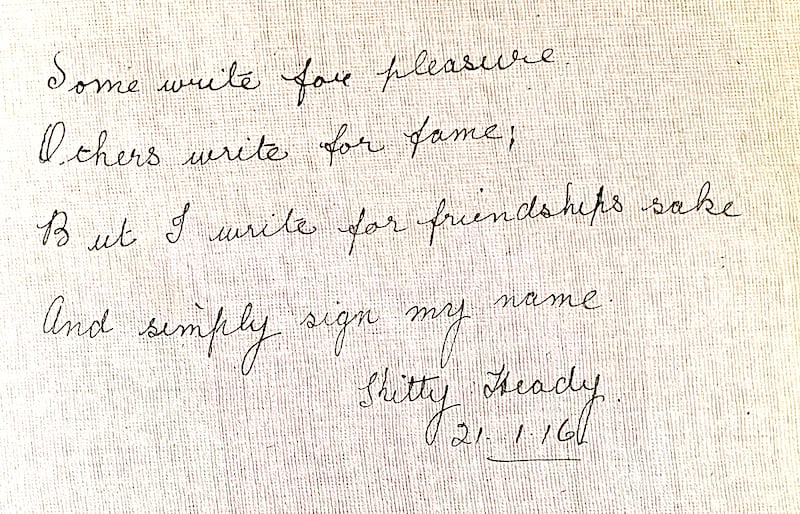
Out of my entire collection of ephemera — that I currently own — this is the only example of profanity I have come across so far. The entry I most want to talk about, however, is the following one made by Lucy in the spring of 1915.
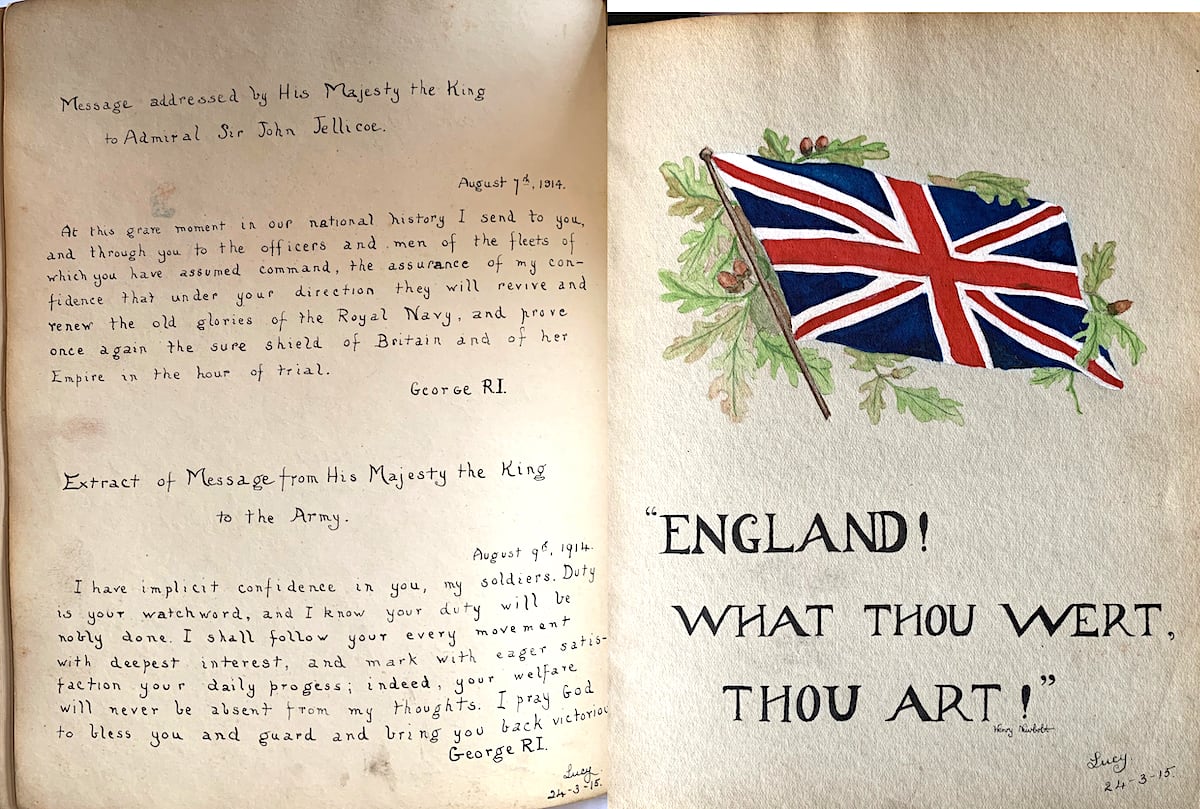
Pictures of Union Jacks, along with flags of the Allies, are ubiquitous in autograph books of the period, and this is archetypical of such entries. I am guessing from the slight wonkiness in the handwriting that Lucy is young but has put a great deal of effort into it. As for the content, 'England What Thou Wert Thou Art!' was a line from the Henry Newbolt (1862-1928) poem 'The Vigil'.
The Vigil
England! where the sacred flame
Burns before the inmost shrine,
Where the lips that love thy name
Consecrate their hopes and thine,
Where the banners of thy dead
Weave their shadows overhead,
Watch beside thine arms to-night,
Pray that God defend the Right.Think that when to-morrow comes
War shall claim command of all,
Thou must hear the roll of drums,
Thou must hear the trumpet's call.
Now, before thy silence ruth,
Commune with the voice of truth;
England! on thy knees to-night
Pray that God defend the Right.Single-hearted, unafraid,
Hither all thy heroes came,
On this altar's steps were laid
Gordon's life and Outram's fame.
England! if thy will be yet
By their great example set,
Here beside thine arms to-night
Pray that God defend the Right.So shalt thou when morning comes
Rise to conquer or to fall,
Joyful hear the rolling drums,
Joyful tear the trumpets call,
Then let Memory tell thy heart:
"England! what thou wert, thou art!"
Gird thee with thine ancient might,
Forth! and God defend the Right!
The poem was written in 1897, when Newbolt was a young unknown lawyer, and published as part of a collection of ballads titled Admirals All and other Verses which would become one of biggest poetry success stories in the 1890s. The pamphlet would be reprinted a further four times, selling over 30,000 copies, and launched Newbolt into the limelight.3
Much of Newbolt's work of the period is of a similarly patriotic — bordering on (sometimes penetrating) the jingoistic — tone. 'Vitaî Lampada' is a poem about a future soldier learning the meaning of duty and loyalty on the cricket field at school, while 'Drakes Drums' tells of a mythical drum, left by Sir Francis Drake, that if played when England was in peril would cause Drake to return — these are probably the most well-known pieces of his from the period.
In terms of the 'Vigil', there is another line which deserves a further look: 'Gordon's life and Outram's Fame'. Gordon refers to Charles George Gordon, more famously known as Gordon of Khartoum, and Outram refers to Sir James Outram who fought in the Indian Rebellion of 1857.4 Both individuals were part of the pantheon of Victorian heroes, sitting on a larger pyramid of English warriors, which were prominent in popular culture of the time. Behind the lionisation of such men — or in Boudicca's case, women — was the driving of an image of Empire, civic-duty, Christian standing, and sacrifice. They, and their exploits would have been told, and retold, in the classroom, in the press, stage plays, early cinema, and there was even an 1898 board game where players could re-enact Gordon's exploits in the Sudan.5
The pre-war period would also see Newbolt's reputation and influence undergo a meteoric rise; as well as having further poetry collections, novels, histories, and collection of short stories published, he would become editor of the Monthly Review (London) between 1900 and 1904 — a periodical which covered a wide range of topics with contributions from a number of leading figures of the day. Figure 4 shows the contents of the November 1903 issue.6
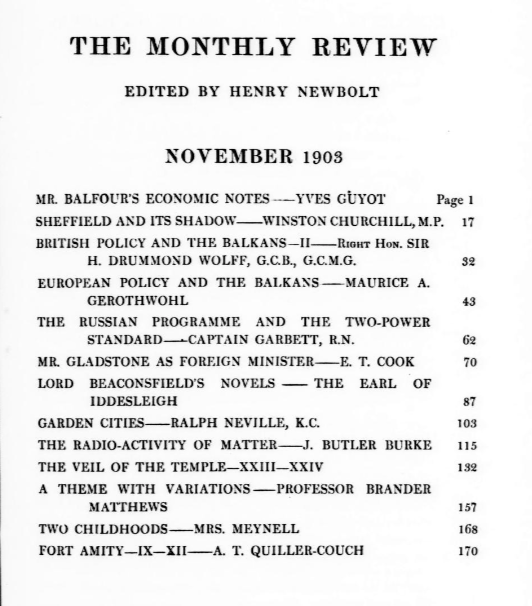
Though the Monthly Review only enjoyed moderate success, it was well respected and it both established Newbolt as a man of letters and allowed him to earn his living solely through writing.7 More pertinently, as editor, he gained a reputation for providing a mouthpiece, which naturally stirred the occasional controversy. For the sake of brevity, it appears he had a knack for backing the right horse in these instances. One example was publishing the letters of his friend, which were highly critical of naval policy. That friend was none other than Sir Julian Corbett (1854-1922), who would go onto revolutionise naval strategy and thinking, and the act of publishing those letters bought Newbolt into contact, and found him favour with, the First Sea Lord John 'Jacky' Fisher (1841-1920).8
In the public sphere, between 1908 and 1909, Newbolt made his first foray into the matter of improving the nation's education as he spoke at several evening classes that were put on for teachers in the London area.9 In later life, as a government advisor, he would write The Teaching of English in England in 1921, more commonly known as the Newbolt report, which would codify and lay the foundations for the teaching of modern English — its influence still generates much discourse today.10
In 1914, his name frequently appeared in the press, whether it be a letter to The Times, commenting on a matter of the day, a quote from his work, an announcement of a lecture, or — what seems to dominate in the immediate prelude to the war — his upcoming novel Aladore, which was being serialised in Blackwood's magazine.11
The reason for decanting the above is, on the very first day after war was declared, 5 August 1914, The Times chose to republish 'Vigil' on its leader page — making it the first poem to be associated with the war — and it was widely syndicated across regional papers.12 As an editorial choice for the time, and as an effort to stir patriotism, I don't think you can fault it, given Newbolt's reputation, popularity, and the resonance of the poem's context — especially the line 'Pray that God defend the Right', which suggests the war was a just one.
As for how it ended up being quoted by Lucy in an Autograph Book: in September 1914, Henry Newbolt was one of a group of writers — which included the likes of H.G. Wells, Arthur Conan-Doyle and Arnold Bennett — who were brought into the War Propaganda Bureau to be involved in the creation of propaganda for both home and abroad.13 For his services in raising the nations élan, Newbolt would be knighted in 1915 and made a Companion of Honour in 1922.14
At the end of 1914, the postcard firm Raphael Tuck and Sons started printing a series of postcards which carried Newbolt's 'England! what thou wert, thou art!' quote, and Lucy's entry is a clear copy of the following.15
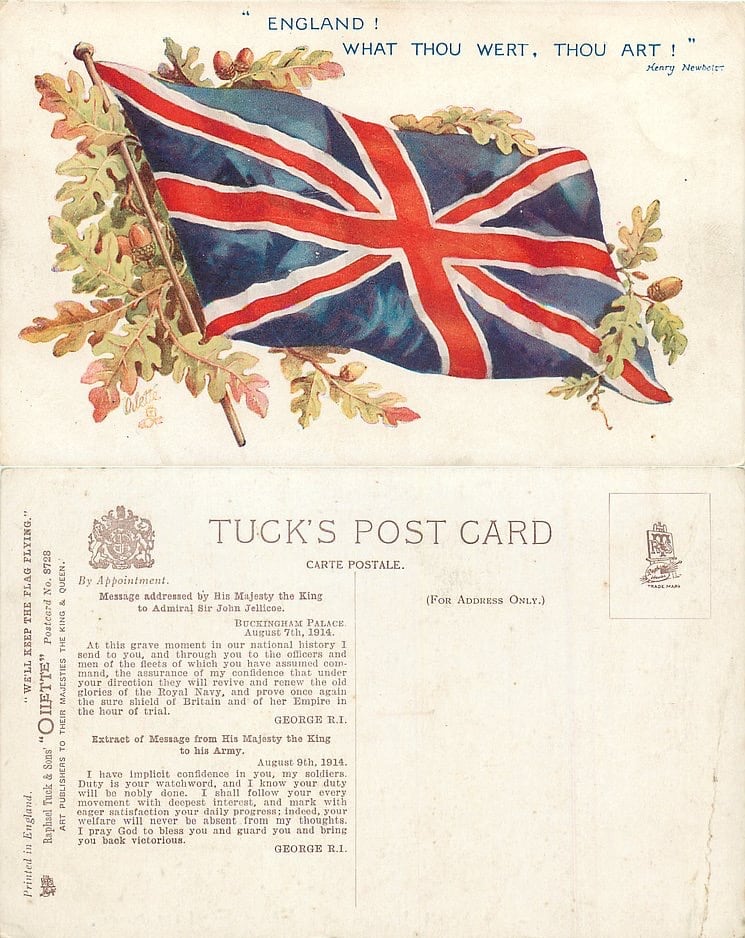
Postcards were seen as an effective tool of propaganda, as they were cheap, popular and readily available.16 In 1913 alone, there were nearly one billion postcards posted in the United Kingdom.17 Given Lucy decided to put the time and effort into copying it out into an autograph book, the message in this case reached a further audience. This could therefore be seen as an example of the medium's effectiveness — or is it?
As mentioned, entries like this were ubiquitous for the period. But I can't help but wonder how much of this was this down to social convention. One thing I have noticed from researching soldier's ephemera is that, in their own sketchbooks and trench journals, propaganda — or the overly patriotic — is more likely to be parodied, such as the following example in Figure 6 from Pow-Wow, the unofficial journal of the University and Public School Battalions.
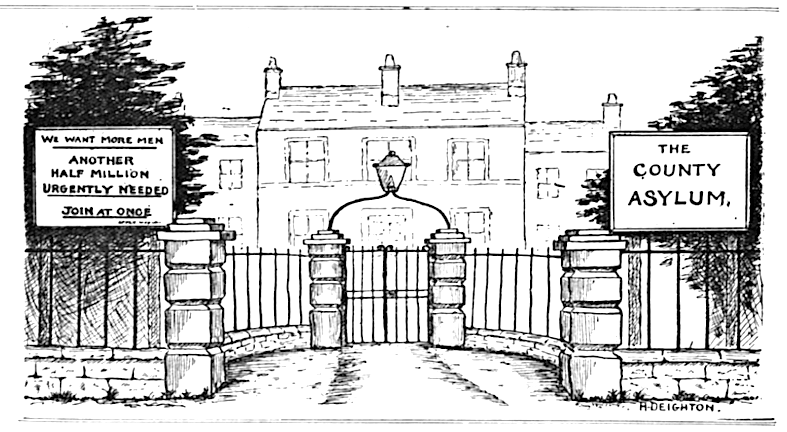
Propaganda in autograph books tends to be straight and serious — a convention soldiers seemed to have followed themselves when leaving their marks in civilian books — which is why I am curious as to whether entries like Lucy's were a genuine show of patriotism, seen as the acceptable thing to do, or just successful propaganda — or even a mix of all three?
I don't know the answer to this but as this project goes on, flagging such entries might lead to providing some insight.
Language
Still very early days on this front, as there are not enough entries captured to do anything meaningful, but I want to keep this section, for now, to serve as an introduction to what lies ahead.
I thought I would look and see if, across the four books captured, there were any common words in use. A caveat: while stop-words have been filtered out, there is still more (such as dates, etc.) which would be beneficial to remove, but for now, the table in Figure 7 shows the top 20 words used by source. It's interesting to note that the word 'love' appears in the top 10 of all the books examined so far.
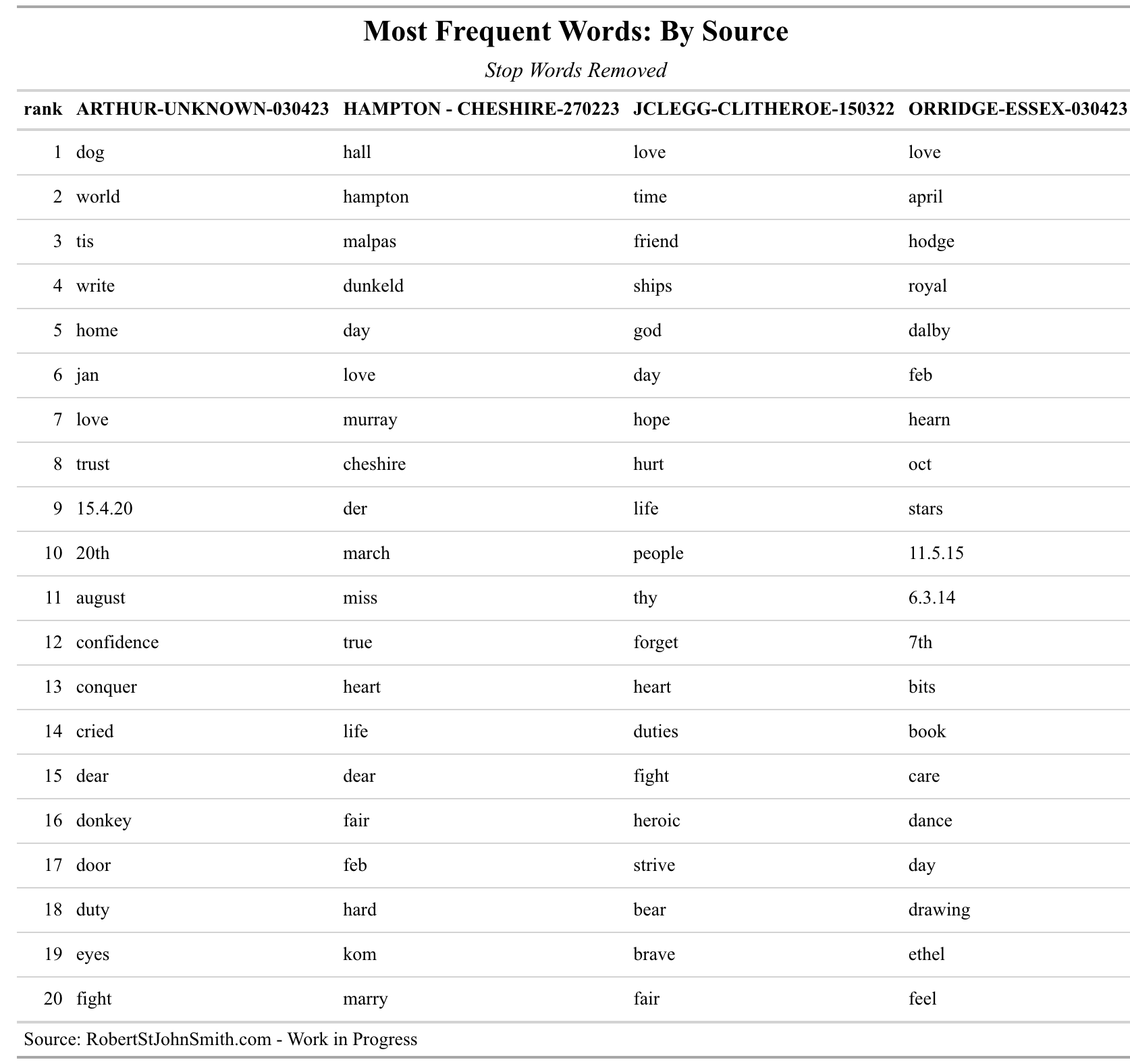
As before, all the entries can be found here and are shared under a creative commons licence.
The entries for Arthur's autograph book can be found in the folder 'ARTHUR-UNKNOWN-030423'. There is a text document and photograph for each page. A spreadsheet called MasterRecord, in the root directory, contains the meta-data.
The Technical Bit
Behind sharing my ephemera collection, I am also plotting these entries onto a matrix to model them. This is very much a work-in-progress, and the following are some notes on the process — which may be of limited interest.
The script for producing the language table can be found in 'Language — Top Words — WIP'.
There is also another new script, which may be of interest, called 'Language — Vocabulary Size — WIP' which shows the number of entries along with the total number of words used.
I mentioned in the last update that the matrix was getting messier — and that was a good thing — and I want to expand on why in this post.
In terms of matrices, it is a lot easier to tidy up than it is to create, especially in this case, where it is being done in the spirit of exploration rather than seeking a clear goal. In total, there are currently 175 entries plotted on the matrix. As by its definition a matrix can be sliced and diced, it is beginning to get easier to see what belongs together.
There are currently two columns for this purpose on the matrix, which I have added to identify the category of an entry: Type and Sub-type. Because there is now a reasonable number of entries it is possible to get a first glance at what a 'model' autograph book should contain, as in Figure 8.
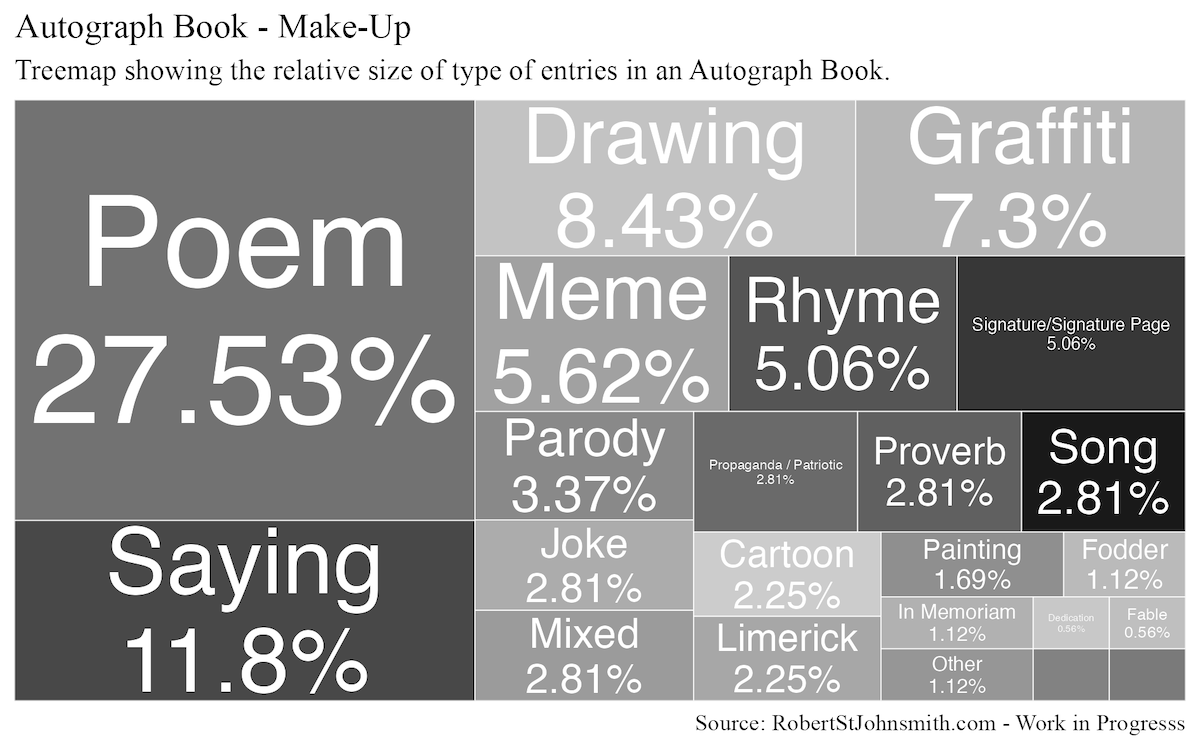
There are plenty of caveats, for example, should limericks be categorised as poems? Is a proverb a saying? What happens if it is both a poem and a parody? At this stage it is more important to get something down as, just as it is easier to tidy, it is even easier to tweak. On that note, ideally a matrix should be binary i.e., 'is it X, yes or no', but for now I am keeping a classification of Type fluid purely for convenience.
From this first look, I don't think it's a million miles off. I would say graffiti seems too prevalent, and propaganda/patriotism too uncommon. I also know, from other books in my collection yet to be plotted, that there is a lot missing — such as photographs and clippings. But if we were to group poems, limericks, and rhymes together, and conclude they make up roughly a third, or the largest portion, of an autograph books content, that feels about right.
From experience, what I would expect to happen is, as more books are added, the top five types become static in terms of how they rank. As more entries are added, the rest will begin to flatten to out. My gut is telling me that this is likely to be when the number of entries plotted is in the thousands — so a very long way to go.
The code for this treemap can be found in the file 'TREEMAP — MAKE-UP-WIP'
The reason for wanting a 'model' autograph book is so it can be used to strip out the ordinary, leaving behind the extraordinary. It is in the latter where the insights are to be found.
-
https://www.doaks.org/research/library-archives/dumbarton-oaks-archives/collections/ephemera/names/valentine-sons, retrieved 7 November 2023. ↩︎
-
Lyttleton Times, 5 December 1910, p.3; Dundee Evening Telegraph, 16 December 1910, p.2. ↩︎
-
James G. Nelson, 'Elkin Matthew's Shilling Garland Series', The Papers of the Bibliographical Society of America, 78 (1) (1984), pp.34-35. ↩︎
-
Victor Shea & William Whitla, Victorian Literature: An Anthology (London: Whiley Blackwell, 2015), p.908. ↩︎
-
A. Watson, Bereaved and aggrieved: combat motivation and the ideology of sacrifice in the First World War', Historical Research, 83(219),pp.149-150; Leamington, Warwick, Kenilworth & District Daily, 16 September 1908, p.2; Eastern Daily Press, 24 March 1908, p.4; Rosalin Joan Sarah Kennedy, 'The Children's War: British Children's Experience of the Great War' (PhD, University of London, 2006), pp-28-29; National Army Museum,1995-01-290-1, 'Gordon-Kitchener or the Conquest of the Soudan' board game. ↩︎
-
Henry Newbolt, My World as in my Time Memoirs (London: Faber & Faber, 1932), pp.237-249. ↩︎
-
Vanessa Jackson, 'Patriotism is not enough: A Reappraisal of the Poetry of Henry Newbolt (PhD, Bowling Green University, 1990), pp.6-7. ↩︎
-
H. Newbolt, My World, pp.255-257 ↩︎
-
R. Kennedy, 'The Children's War', p.124 ↩︎
-
David Aldridge & Andrew Green, 'Newbolt and the construction of subject English', English in Education, 53(5) (2019), pp.195-198. ↩︎
-
Broad Arrow, 29 May 1914, p.16; Cheltenham Examiner, 4 July 1912, p.4; Evening Mail, 1 April 1914, p.2; Liverpool Echo, 31 July 1914, p.4. ↩︎
-
For example see: Evening Mail, 5 August 1914, p.6; Acton Gazette, 7 August 1914 p.7; Bradford Daily Telegraph, 5 August 1914, p.4 ↩︎
-
National Archives, TNA/11992/17627, Report of the Work of the Bureau established for the purpose of laying before Neutral Nations and the Dominions, the case of Great Britain and her Allies, 22 July1915. ↩︎
-
Derek Winterbottom, Henry Newbolt and the Spirit of Clifton (Bristol: Bristol Record Society, 1986), p.67,75. ↩︎
-
As well as the postcard featured, numbers 8719 and 8727 also include the saying. ↩︎
-
Eric Williams, 'Daddy what did you do in the Great War?: Deconstructing British Visual Media Propaganda in World War I' (PhD, University of Akron, 2021), p.253. ↩︎
-
John Fraser, 'Propaganda on the Picture Postcard', Oxford Art Journal, 3(2) (1980), p.39. ↩︎